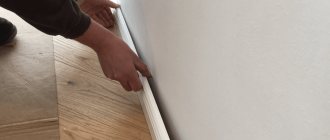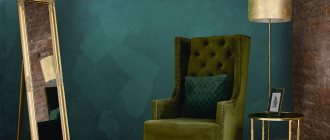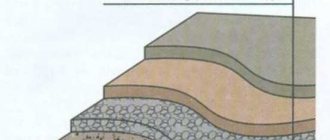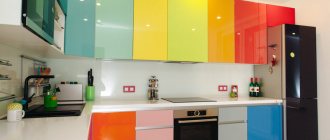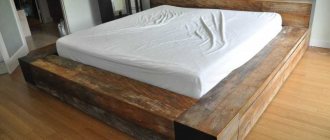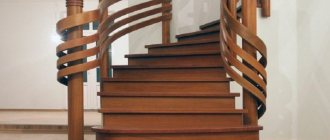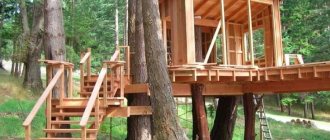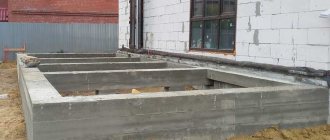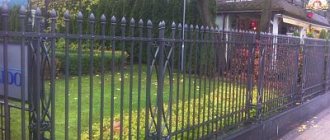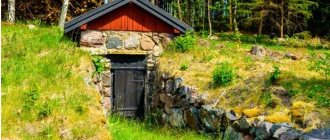Parquet is always a luxurious, beautiful, noble and stylish interior. But nothing lasts forever, and over time, this flooring wears out, its shine is lost, scratches appear, and the varnish or oil coating wears away into wood. All this does not contribute to an attractive appearance; sooner or later you will have to scrape the parquet.
The technology for repairing and updating the top layer does not require any special skills, but is quite labor-intensive and includes several stages of sanding, which must be strictly followed in order to end up with a reclaimed floor that shines “like new.” Next, we will tell you in detail how to sand parquet with your own hands, what tools you will need for sanding, and how to choose the right abrasives.
Parquet scraping will return the coating to its former aesthetics
How to restore a floor manually?
High-quality scraping of old parquet, although it requires more effort and time, can be done manually. To do this, use a knife plane or a special grinder, as noted above. If it is a knife, then the blade is slightly bent and hardened with a hammer before starting work.
It’s even easier and more convenient if a special tool replaces the knife or grinder - a hand scraper with a handle made of plastic or wood. Before starting work, just as in the case of using a special tool, the floor surface is moistened with water. This little trick will not only make the process cleaner, but will also make it easier in every way. Loop the floor from the center to the wall, so that the stripes overlap each other. You can sand the finished surface using an electric polisher with sandpaper attached to the brush.
A manual scraper for parquet is not an option when you need to restore the floor quickly and efficiently with your own hands and without experience in such repairs. But with minimal experience and time, even with manual processing, you can achieve positive results, saving a decent amount on renting professional tools and the services of craftsmen.
A hand scraper is cheaper than electric equipment, but it may take some time to learn how to use it
Cycling or replacing parquet is the right decision
Classic sanding of parquet floors involves removing the top layer of wood, followed by sanding and finishing with varnish mixtures. Depending on the thickness of the coating, the floor can withstand from two to eight restoration cycles. You can only work with a prepared dry coating, so before proceeding to sanding, you need to make sure that the floor:
- not dry (there are gaps between the slats, and they are small);
- did not swell;
- has no serious damage;
- was not attacked by wood-boring beetles;
- does not rot;
- has sufficient thickness for work (at least 5 mm).
The question of whether it is possible to scrape the floor with the problems noted above is answered positively only if the defects are eliminated and the damaged areas are replaced before the scraping begins.
Sometimes it is better to replace the parquet than to waste time and money on sanding boards that have already outlived their useful life
Final actions
Despite the fact that all modern grinders are equipped with reservoirs for collecting debris, after finishing work it is recommended to clean the floor with a construction vacuum cleaner. If necessary, the dust removal operation is repeated the next day.
If there are cracks, they are sealed with a putty solution, adding the remains of sawdust from sanding to it - this way you can maintain the uniform color of the wood. The surface is sanded with fine-grained sandpaper.
After this, the floors are varnished. The next layer is applied after the previous one has completely dried, in accordance with the manufacturer’s instructions. It is not recommended to apply more than three layers. The boardwalk can also be painted with oil paint (enamel), choosing a color in accordance with the interior.
Beautiful interiors
The floor in an apartment, room or house made of natural parquet always looks presentable and beautiful, regardless of the wood species from which it is made. There is a cheaper version of parquet flooring, which is called panel flooring: when making its surface layer, more expensive wood materials are used, and underneath there are coniferous wood, which should be taken into account when sanding.
Of course, the elite option with oak parquet is still the most reliable and time-tested. The massiveness and strength of oak is always in first place compared to other trees. Such a floor can be cycled up to 8 times during the entire period of its “life”.
Work on high-quality oak parquet is always easier and much faster than with other materials, which justifies its high cost. Oak parquet will look great in a residential building or apartment, but it looks best in large rooms for various purposes: museums, concert halls, reputable banks and other public institutions.
Thanks to the advent of modern parquet processing technologies, different types of wood can be bleached and lightened to the required tone without damaging the texture and inner layers. Previously, birch or maple floorings were considered the lightest, but now even red oak parquet can be made almost white, so the texture of the wood will not suffer at all, but, on the contrary, will be properly emphasized.
Neutral colors of natural wood will suit any interior ensemble (pine, birch, maple). There is no originality in this, but you can choose any furniture and style. Parquet in combined colors with alternating dark and light shades will ideally fit into a modern style - hi-tech, minimalism or even loft.
Dark-colored parquet can look universal if the room contains dark brown furniture of any shade. For classics, it is most preferable, but it also looks good in interiors decorated in oriental colors.
The dark tones of the parquet give the room additional coziness and intimacy, despite the fact that they contribute to the visual narrowing of the space. Although in large square-shaped rooms this can, on the contrary, become an advantage.
If the owner of a parquet floor is lucky, and the wood that is to be subjected to the sanding process is of good quality, after carrying out the main work, you can think about what tone to choose for the coating - dark or light. Painting the floor is also possible if the material is strong. If it is possible to completely change the color of the coating without damaging its structure, this is an excellent solution when you plan to radically change the color of the wallpaper, furniture and the general background in the room.
Modern scraping and sanding machines allow the restoration of parquet flooring to be carried out in a gentle manner and in the shortest possible time, and high-quality wood offers the restorer the widest possible opportunity to renew the flooring and preserve it for many years.
Surface grinder Trio
A universal three-disc device for fine sanding of surfaces made of wood or cork, and for treating oiled or varnished floors. If we are talking about wood, this model is used after basic leveling with drum or belt units. Having three discs at once increases the efficiency and productivity of the machine. The device is similar to mosaic grinders: three disks rotate around a common center, while each of them additionally rotates around its own axis.
The floating seating of the discs, as well as the powerful built-in vacuum cleaner, make it possible to create a perfectly smooth surface without the formation of clouds of dust. Therefore, when working with this power tool there is no need for professional protective equipment. The original design ensures ease of control of the machine, reliable and very accurate balancing of its components. For the most convenient carrying, the unit can be disassembled into two parts.
The equipment has a power of 1.8 kW, requiring power from a 230 V network. The width of the treated surface is 460 millimeters. The total weight of the machine is 77.5 kilograms, the structure is divided into two parts weighing 24 and 53.5 kilograms.
Scraping technology - step-by-step instructions
The technology of work is simple, and at home everything is done in exactly the same way as on a large scale.
Parquet preparation
Before sanding old parquet (panel, typesetting, etc.), it is necessary to prepare the room. All furniture and other interior items must be removed from it.
If heavy furniture cannot be removed from the room, then it should be covered with film and all joints of the covering material should be sealed with masking tape. Otherwise, the smallest particles of dust and debris will end up under the film, and it will be very difficult to remove them from the furniture.
You also need to remove curtains from the windows and decorative elements from the walls. Lighting fixtures, switches, and sockets should be properly wrapped with stretch film.
After inspecting the floor and identifying swollen, severely damaged, deformed boards, replace them with new ones. If some dies creak, the creak is eliminated using wooden pins. To do this, drill a hole (8 mm) between the dies at an angle of 45 degrees and install a pin coated with PVA glue into it. The protruding part is cut off using a chisel.
If there are loose boards, they are nailed to the base of the floor. Holes for nails are made in advance. It is better to putty on top of the nail heads with a mixture of sawdust and parquet varnish.
Finally, you need to clean the parquet from debris with a vacuum cleaner and start sanding.
Primary grinding
Rough sanding of the floor involves removing the top layer of parquet flooring - this is the first stage of sanding. It is performed with a grinding unit or a hand tool - a scraper. The abrasive material for the primary abrasion should be No. 40, and for the second - No. 80.
The machine must move evenly across the parquet, without stopping, otherwise grooves will form, which will make the floor uneven and spoil its appearance.
Each subsequent pass should be shifted relative to the first by half the width of the drum. The abrasive material must be replaced as it wears out.
Hard-to-reach areas, in particular along walls, under heating radiators, are best sanded using an angle grinder. If you have the appropriate experience, this manipulation can be done with a grinder or a hand tool - a scraper. When working with cycles, to simplify the process, it is recommended to moisten the wood by spraying water from a spray bottle onto the parquet.
Covering up defects
Upon completion of the initial scraping, all existing cracks and irregularities should be sealed. Wood putty should be used to fill all large depressions on the parquet, places where pins and nails are fixed, as well as obvious scratches on the floor. It is more effective to fill deep cracks in two passes. A good way to save putty is to use a special stencil.
Apply the finished product to the entire parquet floor in a thin layer, using a rubber spatula. It is easy and simple to work with on wooden surfaces. When the solution is completely dry, you can imitate the connection of the planks by using a sharp awl and a ruler.
Secondary sanding with fine abrasive
Having completed all the work to eliminate defects, they move on to fine sanding. The surface grinding unit is carried out in a circle, where first they use abrasive material No. 100, then No. 180 and finish finishing with sandpaper No. 240, it is done exclusively along the fibers. This sanding allows you to remove excess putty from the parquet and get a perfectly smooth floor.
After sanding the parquet, debris should be removed from the entire surface; for finishing it should be free of dust and absolutely clean.
Questions and answers
Is it possible to cycle parquet in a room with furniture?
Cycling in a room with furniture is difficult, so it is recommended to remove all furniture before starting work. If necessary, our staff will help you carefully remove furniture from the premises. If large-sized furniture cannot be removed, then our craftsmen will carefully bypass them during sanding. Our parquet floor technicians have small angle grinders in their arsenal that allow you to sand the flooring without scratching or damaging the furniture.
Is there a lot of dust and noise during scraping?
When carrying out parquet work, there is always dust, but thanks to our sanding equipment, it has built-in vacuum cleaners and dust collection bags; a minimal amount of dust gets into the air. Typically, sanding dust does not rise above knee level. This means that it is better to cover valuable items with dust film, and items that are not of great value can be left. Sanding work is always associated with noise - parquet equipment makes about the same noise as a standard household vacuum cleaner.
What kind of parquet cannot be sanded?
Any parquet that lies firmly and does not have dies torn off from the base can be sanded. If there are torn areas on the floor, then with thoughtless sanding, the planks can be damaged by sanding machines. Therefore, in this case, our craftsmen first carry out restoration work and only then begin sanding.
Is it possible to scrape parquet without removing the baseboard?
It is quite possible to bypass skirting boards when sanding using angle grinders, however, areas of old varnish covered by the skirting board will not be sanded. Therefore, later, when replacing the baseboard, the old coating may appear around the perimeter of the rooms.
When is it better to order scraping - before or after wallpapering?
Sanding can be done in both cases, but it is preferable to finish the work on the walls and ceilings first before moving on to the floors. At the same time, after gluing the wallpaper, it is better to postpone the installation of the baseboard until the very last moment - this way the parquet floor workers will be able to peel off all the old varnish, including in the corners of the rooms.
Read with this
- Parquet floors: do-it-yourself parquet repair and restoration
- Restoring parquet without scraping: a second life for the floor
- Features of parquet varnishes
- How to properly lay parquet boards on a concrete floor?
- What is parquet and what types of parquet are there? photo of parquet
- Electric heated floor in a private country house: installation features in a wooden and frame house
- Herringbone parquet in the interior
- Optimal temperature for heated floors
- Step-by-step technology for pouring self-leveling floors
- What is the difference between laminate and parquet?
Floor finishing
A parquet primer will help complete the repair. This coating, which makes the board stronger, increases impact strength. But if the parquet board is made of hard wood (oak, teak, hornbeam), then it is not necessary to prime it. The composition is applied according to the instructions with a brush or roller, then it must dry. The drying time of the primer is 2-3 days, then finishing sanding is carried out manually or with a machine using fine abrasive sandpaper - this procedure removes wood fluff.
Now comes the stage of cleaning the floor from the smallest particles and dust, as well as applying varnish. The coating should be varnished over the entire area at once, moving from the far wall to the exit. 2-3 layers of varnish are applied, each subsequent one only after the previous layer has dried. The varnish composition dries on its own, you need to monitor the level of humidity, temperature changes and it is better to generally close the room from drafts.
Drying time depends on the type of varnish composition. As a rule, the entire procedure does not take more than 6-5 days, and the result is a perfectly beautiful varnished parquet floor that will last for quite a long time.
(1 ratings)
New life for parquet - how to restore it?
If previously it was believed that sanding correctly meant removing the top layer of wood from the coating, today the use of special equipment also allows sanding the surface, thus reducing the amount of work and the time during which they are performed. After scraping and subsequent sanding, the parquet looks well-groomed and new, maintaining its aesthetic qualities for many years.
The most common types of equipment for carrying out work are drum and belt sanding machines; in some cases, surface grinding machines are also used. The floor restoration process consists of several stages:
- Rough sanding to remove the old layer of varnish and wood along with any rough edges.
- Repeated sanding of the parquet using a disc-type surface sander to remove defects and make the surface even.
- Sanding surfaces in hard-to-reach places (manually or with a sanding machine).
- Filling cracks with applying the mixture to the surface of the parquet.
- Gently sand to remove excess putty.
- Cleaning the floor from debris with a construction vacuum cleaner.
- Finishing the finished surface with a varnish mixture (several layers).
When choosing sanding tools and equipment, it is worth remembering the advantages of models with a bag for dust and sawdust. The presence of this element will greatly simplify the work, and most importantly, make it cleaner, faster and more enjoyable.
Well-chosen equipment will allow you to spend less time and effort on the work itself and on cleaning up after it.
Necessary equipment
If you have weighed all the pros and cons and still decide to scrape the floor with your own hands, then you will need:
- a drum sander, with which the varnish layer is cleaned and the first rough sanding is performed;
- surface grinder for finishing grinding;
- angle grinder, which is necessary for cleaning hard-to-reach places. Without it (or an angle grinder with attachments with a diameter of 125-150 mm as an alternative), high-quality sanding of floors is impossible;
- industrial vacuum cleaner – cleans the surface of construction dust before applying varnish. Sanding parquet without dust is impossible, and it will not allow you to properly apply a layer of varnish.
Purpose of the procedure
When sanding an old wooden floor, cracks and sags, stains from oil and other stubborn dirt are eliminated, which ultimately extends the life of the coating. After sanding, a floor made of any wood looks much better. You can scrape not only parquet, but also simple floors made of pine boards.
If the boards are very worn out (thin), rotten, or loose, then they need to be replaced. You can carry out scraping with minimal material costs if you rent a machine and do all the work yourself. Let’s figure out what the sequence of actions is, whether it’s possible to repair the floors yourself or whether it’s wiser to invite specialists.
The most inexpensive way is to use a hand scraper, which is a scraper with a metal tip. An alternative is to use sandpaper sheets attached to a holder. These methods require virtually no money, but are very labor-intensive. Therefore, they are usually used for cosmetic spot repairs, and when comprehensively updating a wooden floor, machine options are preferred.
Photo report preparing the apartment for scraping and polishing
A very important point, the tape must be glued to the bottom of the wall!
This will prevent the film from rising up when sanding the parquet. The amount of dust will be minimal; it will rise and settle on the walls no higher than 1 meter from the floor. If you have fabric, porous wallpaper or parquet that needs to be tidied up, laid from exotic, oily, paintable woods - in this case it is necessary to cover the walls!
Carefully spread the film upward to its full height. The film comes in different heights, the optimal height is 1.4 - 1.6 meters
This film is very thin and magnetized, it does not need to be glued to the walls, but just needs to be applied to it. It will stick to her like feathers to clothes. Thanks to it, a barrier is created between your wall and parquet dust. At the end of the work, the static film can be easily removed from the wall along with any remaining dust. To complete the pasting, it is necessary to expel any remaining air between the wall and the film.
This can be done using a roller.
Upon completion of the parquet work, you receive a clean room with a new floor.
You can use this service from us or do it yourself.
Beware of craftsmen who use grinder-type machines or hand grinders to process hard-to-reach places. cars, etc.
Preparing the base - the initial stage
Restoring or sanding a floor, like any other type of work, involves a series of preparatory work. The area allocated for treatment must be treated with water. This must be done so that during the removal of the top layer of the floor, as little dust as possible is generated. Another interesting method to reduce the amount of dust and dirt in the process is to iron the floor covering through a damp rag.
The floor surface ready for restoration must not only be clean and moistened. Before starting work, you need to dismantle the baseboards, monitor the possible presence of nails around the perimeter of the floor (they can damage the equipment), and solve problems with creaks, chips, cracks and potholes.
The scraping of the parquet board begins from the central part of the room, gradually moving towards the walls. The treated strips should overlap each other and reach the central part of the room. During the finishing process, strips of looped parquet must move in both forward and reverse directions.
Preparing the floor, like the main part of the work, can take a fair amount of time, but it’s worth paying due attention to this process
Equipment for parquet scraping
There are two types of tools and equipment used when working on wood floors: mechanical and electrical. The former are good for small areas, while the latter can process large areas in one shift of 8 hours.
Manual scraping is carried out using a so-called cycle or scraper. It is a metal plate that is bent at an angle of 45° relative to the handle. Most often used to remove paint from a surface. Further grinding is carried out using a grater with sandpaper attached to it or a power tool.
Parquet scraping technology requires the following equipment:
- Belt parquet sanding machine equipped with a drum with a nozzle made of roll sanding paper. Available with single-phase and three-phase drives of different power. Almost all models come complete with a fabric sawdust collection bag, which allows you to work on parquet without dust and large debris (almost). The cost of the unit depends on many parameters. Small household models weighing up to 12 kg, with a working belt width of up to 10 cm, will cost 20,000-40,000 rubles. Professional devices work both as scraping and grinding machines. They are distinguished by their considerable weight (up to 100 kg), useful cross-section of the sanding attachment up to 25 cm and high price - at least 100,000 rubles. For one-time work carried out independently, it is better to rent equipment for 1-3 days.
- Surface grinder with 1 or 3 disc abrasive attachments with a grit size of 120 units and above. Necessary for fine sanding of parquet floors, as well as for intermediate leveling when applying varnish compositions. This type of machine is classified as professional, so the cost is appropriate - from 60,000 rubles. and higher.
- Angle grinders for parquet, better known as “boots”. With their help, you can treat any hard-to-reach places (under wall-mounted heating devices, in corners, etc.). To work, you need circular nozzles of the appropriate grain size. Like large units, they are equipped with a bag for collecting sawdust and are rented or purchased based on the volume of work. The price of household universal models starts from 3,000 rubles, professional ones – from 40,000 rubles.
- Construction vacuum cleaner. Used separately or in conjunction with a scraper or grinder. In the latter case, you will need a special “adapter” to connect the hose and the machine itself.
Sanding parquet also requires a whole set of components - abrasive belts and wheels, scissors, tools for fixing sanding machine elements. Don't forget about your own protection. In particular, earplugs, gloves, a respirator and goggles will protect you from many health problems.
What tools and materials need to be prepared?
For high-quality scraping of parquet, special equipment is required. It is not advisable to buy it for personal use due to its high cost (unless, of course, you plan to do scraping professionally), but renting such a tool is quite affordable.
So, you will need:
- Drum-type sanding (parquet sanding) machine – rental cost is about 600 rubles/day.
- Surface grinder for scraping parquet – rental cost from 1,500 rubles/day.
- "Boots" - equipment for sanding corners. It should be noted that such equipment appeared relatively recently, and before that, corner processing was done with a manual scraper or a grinder with a special attachment. So you can easily get by with the “old-fashioned” methods and save a little.
- Sandpaper in rolls. You will need several types of abrasive: for rough processing P40, and for sanding P80 or P120 (depending on the type of wood).
- As auxiliary equipment, you need to prepare scissors for cutting sandpaper, keys for the clamps on the drum of the sanding machine (usually they come with the machine, but anything can happen with rented equipment), and a powerful vacuum cleaner.
Remember that the weight of a scraping or grinding machine can be about 70 kg, so it’s not worth it for a fragile woman to carry it alone. But the dimensions of the unit allow it to be transported in the trunk of a car. As a rule, renting a car for one day is enough.
Sanding (parquet sanding) machine
Working with a "boot"
After making simple calculations, you will understand how much it costs to scrape parquet with your own hands. The figure that a construction company will ask for the work will be several times higher.
What equipment is used to restore the floor?
In order for dust-free parquet sanding to become a reality, it is worth choosing the right tools and equipment for independent work. The required set includes:
- drum-type parquet grinder;
- surface grinder;
- hand scraper, angle grinder for finishing hard-to-reach areas;
- industrial vacuum cleaner.
In addition, it will be necessary to prepare means to protect against chips - a respirator, overalls, construction headphones, glasses and a hat. Be sure to have sandpaper with different grit levels on hand for finishing the floor, as well as a spatula with putty, parquet varnish with a brush or roller, and a tool for dismantling baseboards or boards that require replacement.
It is necessary to have a good understanding of the equipment, strengths and weaknesses of manufacturers, so that during work the tool does not fail
Rules of care
If recycled parquet flooring is properly cared for, it will last for decades without the need for repeated restoration.
It is important that a certain level of humidity is maintained in the room. To do this, you can install an automatic device for air humidification in the room, which will prevent premature drying of the wood and creaking of the floor
It is important to ensure that street sand does not get on the parquet. This can be avoided by placing a rug at the entrance
Since natural wood is especially susceptible to ultraviolet rays, you should take care to tightly cover the windows by hanging curtains or blinds on them. To prevent scratches from furniture legs on the parquet, they should be covered with felt on the bottom. The floor can only be cleaned using a wet method and must be done manually.
Cycle for parquet - the wisdom of work
It should be noted that they cycle only for the purpose of cleaning. Leveling is achieved by treating the surface with a plane. Working with cycles is quite simple, but knowing some of the nuances will not hurt you. The processing of new parquet begins with a sherhebel - a special type of planer for processing rough surfaces with numerous irregularities, then the final cleaning is carried out with a planer.
The surface of the parquet is processed along the grain, removing a not very thick layer of wood. To make the planing process easier, it is recommended to wipe the parquet with a wet cloth or moisten it with a wet brush, since wet wood is easier to work with. When the plane and sherhebel have completed their mission, the scraper appears on the “stage”. The “stage” must be carefully swept so that there is no trace of grains of sand or other materials other than wood, since their presence leads to the rapid dulling of the instrument. The floor is also wiped with a damp cloth before work, and the surface is moistened during work.
Do-it-yourself scraping of a wooden floor
A preliminary inspection will help evaluate the feasibility of using process technologies. If elements with severe defects are found, they must be eliminated, and only then choose a manual or machine option for processing the coating.
The manual method is the use of a cycle, and the process will be completed at an extremely slow pace, even for a small room it will take a lot of time. Manual processing has one advantage - the entire thickness of the coating is removed with a scraper in one pass. That is, you can remove layers of paint, varnish, and damaged wood.
But the use of a grinder is not inferior in quality, but it significantly facilitates and speeds up the sanding process. For processing, a grinder is used, mainly a drum type with an abrasive removable belt. Buying equipment is quite expensive, but renting it for a couple of days is something any owner can do. What tool is needed:
- an angle scraper will be needed to process corners indoors;
- an angle grinder with a disc for sanding wood - a tool that replaces expensive sanders;
- manual scraping - if work is planned to be carried out in a small-format room or if difficult-to-reach areas are to be processed;
- vacuum cleaner for removing debris and dispersed dust;
- sandpaper of different grits (from No. 40 to No. 120-140);
- screwdriver;
- polyethylene film;
- mineral alcohol or white spirit to remove paint and varnish;
- putty, glue, spatula for processing cracks.
Machine method
This method is simpler, more convenient and more practical for the home craftsman, even if he has little experience in sanding wooden floors. The coating is processed in several stages, the first of which is the selection of a machine:
- Drum, belt, disk - units for scraping of soft, medium and coarse types, but a drum machine does a better job. The choice between vibration, eccentric and others is better to give in favor of the first - they are universal.
- Household work is carried out using compact, lightweight devices. Even if the power of such equipment is lower, processing the coating will be more convenient for the master.
- You should look at the ergonomics of the machine: the location of the switches, the overall comfort of operation.
The choice of machine determines the sanding of a wooden floor and the price of the work - equipment is rented on a daily basis, so you should first prepare all the passage points to prevent downtime of the device.
The coating processing technology and scraping features of various materials differ depending on the type of boards. In particular, the twisted boardwalk is looped by moving from one corner of the room to another. In this case, after passing several times, you should change the trajectory of movement - go in the opposite direction. Ordinary non-wavy floorboards can be sanded using passes along the perimeter.
For rough initial scraping, abrasive No. 40 is used, then the consumable material is changed to medium-grained sheets. And if the first pass with the abrasive was across the boards, then the medium-grained abrasive goes along the floorboards - this way the coating will cycle much better. All that remains is to go over it with fine-grained sandpaper and then proceed to the final steps.
Scraping of difficult-to-reach areas is carried out manually with a regular scraper or a grinder. If you have an angle grinder, the process will be faster, but more expensive. Processing should also begin with coarse-grain sandpaper, then medium-grain sandpaper, and then treated with fine-grain sandpaper (grinding wheel).
Manual method
Hand processing is the use of cycles. The tool is quite simple and inexpensive. But not every master can make a scraper correctly - the factory tool is immediately equipped with the required angle of inclination and sharpening of the blade. Therefore, the factory scraper removes the correct layer of chips and does not leave burrs.
It is recommended to start working with hand cycles from the middle of the space, gradually moving towards the edge. The process is long and tedious, but the impact on the wood is not so harsh, and pre-cleaning the floor before the procedure will not take much time. There is another advantage if this is manual scraping of floor boards - the price of the process is much lower, due to the lack of expenses for renting equipment.
After sanding is completed, the board is sanded with a grinder or a hand grater to ensure the surface is absolutely smooth and even.
The difference between manual scraping and machine scraping is in the pass method: in the first case, squares are processed, in the second, stripes.
Cost of issue - budget calculation
Obviously, the cost of sanding old parquet depends on whether the work will be carried out independently or by calling a specialist to your home. At first glance, it may seem that the first option is more profitable in all respects. This is true, but only subject to the conditions of surface treatment, the use of proven equipment, and high-quality materials.
Lack of experience in scraping with unreasonable savings on tools, equipment and materials will lead to a negative result - the floor will require re-processing, and this is additional expense. That is why, when deciding to restore the floor yourself, you need to take into account every little detail, from the choice of primer mixture to high-quality varnish.
Before scraping parquet yourself, you need to think carefully about whether it would be cheaper to call specially trained craftsmen with high-quality, proven equipment
Particular attention should be paid to the selection of equipment for the work. Machines for scraping and grinding surfaces must be free of defects, easy to use, and prevent damage to the floor. To ensure the process goes smoothly, you should not refuse instructions from the grinding equipment rental company.
And lastly, no matter how high the price of restoration work may seem, it is not commensurate with the cost of completely replacing the old parquet with a new one. Dismantling the covering with preparing the base and laying a new floor will cost many times more, which means that the restoration process should be approached with all responsibility, without saving where this can leave a negative imprint on the result.
Tool for scraping parquet
There are two ways to perform scraping of parquet flooring - manual and mechanical. In the first method, a hand tool called a scraper is used to scrape off the thinnest layer of material, achieving ideal flatness. There are tools equipped with one or two blades.
Cycles are distinguished by the width of the working part. The processing process is carried out along the wood fibers (along the parquet planks). Like any manual operation, manual scraping of parquet requires a lot of time. The process of sharpening cycles is very complex and responsible. At the same time, even a slight dulling of the cutting edge of the tool leads to a decrease in the quality of the work performed.
Mechanical scraping of parquet flooring is much more productive. To perform it, drum or belt type parquet sanding machines are used.
The main consumable material when performing work using such tools is sandpaper (sanding paper). Depending on the complexity of the work and the magnitude of the height differences between individual coating elements, I use sandpaper of various grain sizes. Some types of devices are equipped with dust bags, which significantly reduces the level of pollution during work.
In addition to these devices, it is necessary to prepare small tools for processing hard-to-reach places located in the corners of rooms or under central heating radiators. The most widespread among the devices used for these purposes are angle grinders (grinders), as well as some specialized tools.
If you decide to sand the parquet in your premises yourself, you need to take care of providing the process with the necessary equipment and consumables. It makes no sense to purchase expensive equipment for one-time work. You can find organizations that rent out this equipment. On average, the cost of operating someone else's tool will cost you from 500 to 1000 rubles per day, plus a deposit of 15,000-20,000, which will be returned to you after the equipment is returned in working condition to its owner. When using an angle grinder, purchase a special grinding attachment.
In addition to the tool, you will need sandpaper with different grain sizes. For a room of 20 square meters you need to purchase 4.5 - 5 square meters of skin. Select grain size from the coarsest P36 to the finest P100-P120. It is advisable to stock up on 1.5 m2 of sandpaper of three sizes of abrasive grain.
To finish the sanded surface, you will need a sufficient amount of putty for parquet floors and varnish for several layers of coating, depending on the type of base and film thickness.
Processing after scraping
In order for the flooring to acquire a rich color, have a matte or glossy tint, and become more impressive and beautiful, after sanding the parquet it must be varnished.
Before applying the varnish, the surface must be vacuumed and washed several times with warm water. The parquet must be clean and dry. When choosing a varnish, you should take into account the effect of color on a specific room so that it does not visually decrease in size or become uncomfortable.
The varnish is applied in several passes. First, the parquet floor is primed to improve the adhesive properties of the coating. When the treated surface has dried well, it is sanded with a fine-grained abrasive material. This technique is necessary to remove formed lint from the floor.
The wooden covering is once again cleaned of dust particles and coated with a high-quality varnish composition.
After the first layer has dried, the manipulation is repeated. For convenience, it is recommended to use a wide roller with velor bristles or a wide brush. Depending on the desired result, the number of layers can reach 7.
If the varnish was applied incorrectly, re-sanding will be required.
Equipment selection
When mechanizing work, several equipment options are used:
- Most often, sanding is provided by a drum sanding machine. Depending on what kind of skin is installed on its drum, rough or fine processing is carried out. At the first stage, sandpaper with a grit of 40 is usually used, and for finer grinding - with a grit of 60. The final processing for the finishing coating is carried out first with sandpaper with a grit of 80, and then with 100. Among the domestic equipment, there are sanding machines SO-206, SO-301, SO -401, SO-318, SO-501. The machines Hummel, Flip, Elan (Germany) are highly reliable. You can also note the Novatek models (Belarus-Ukraine).
- Surface grinding machines are designed for processing large floor areas and thick parquet boards. Structurally, they differ in that they contain several disks with attached sanding paper, which rotate in the same horizontal plane. This device allows you to immediately cover a large surface. Experts especially highlight Trio installations.
- Angle grinder (grinder). It is used for treating floors in hard-to-reach places, incl. in the corners of the room. In such specific conditions, the German Laegler Flip machine has proven itself to be excellent. High-quality equipment is supplied by Trio.
- When carrying out scraping, it is impossible to do without a powerful vacuum cleaner.
Manual technology is based on the use of a special device - a cycle. It is recommended to use factory tools with a high-quality working element. It is worth choosing a device with a short handle. The width of the cutting part must be at least 50 mm. In addition to the cycle, you should stock up in advance on sandpaper of different grits (from 40 to 100), as well as tools for applying the finishing coating (brushes, roller).
Restoring the appearance of parquet in a room with large furniture
Sanding parquet with furniture can be done in several basic ways:
large-sized products are shifted first to the center of the room, and then, when the free space is varnished, they return to their place, allowing the middle part of the room to be processed. The use of modern quick-drying paints and varnishes makes it possible not to delay the procedure for several days, but to complete it in just a day;
if it is impossible to move heavy furniture, it remains in its place. In this case, scraping is carried out in close proximity to it. The only drawback of this method is the need to restore individual areas of the coating after rearranging the house, and to select parquet according to the pattern, color and type of wood;
the use of special FLIP angle grinders, or similar machines that allow processing of coatings in hard-to-reach places.
Using any of these methods, restoration of the appearance of the coating in a large modern apartment is carried out in just a couple of days.
Cost of scraping and sanding parquet and wooden floors
Sanding and scraping of parquet – price per m2 (approximate prices of craftsmen)
It is difficult to name the exact price, because... it develops under the influence of various factors:
- remoteness of the object from the location of the teams (for example, a country house in a village);
- complexity of the work (degree of wear of the floor covering, type of wood);
- work area;
- list of services provided;
- equipment used;
- professionalism of the craftsmen.
Finally, we note that scraping parquet is a responsible, but affordable and very effective procedure that will extend the life of the wooden flooring and bring newness to the interior.
How long will it last?
Processing frequency may vary significantly. It is advisable not to wait for the transition to radical measures. If scratches, chips, numerous stains and abrasions appeared long ago, it is not always possible to eliminate the problem with local repairs.
Cycling the surface layer will allow you to get rid of the problems that have arisen. However, the frequency of such processing may vary. The number of works performed may vary. it all depends on:
- quality of the material used;
- type of wood;
- thickness of the front layer.
The number of treatments can reach 7 times. However, in some cases only a single surface treatment is possible.
Surface scraping is a costly and time-consuming procedure. To refuse such treatment, you should take care of it in a timely manner.
Defect Elimination Technology
If you plan to repair the parquet yourself, you will need step-by-step instructions for each type of work. Let's look at ways to eliminate common flooring defects and breakdowns.
Mechanical damage
During operation, careless handling causes scratches and gouges to form on the coating. The coating can even be scratched by moving a heavy chair without lifting it. Types of mechanical damage and methods for eliminating them are discussed in the table:
Types of mechanical damage and methods for eliminating them are discussed in the table:
Fill with colored putty. If the color is chosen accurately, the restored areas will be invisible.
The sequence for restoring deep scratches on parquet:
- We clean the coating from dust using a vacuum cleaner.
- Fill the crack or scratch with putty.
- After the putty has dried, sand it down with sandpaper.
- We remove all dust generated during the grouting process.
- Apply a thin layer of varnish to a clean, dry surface.
When black marks form, we wipe them with polymer mastic.
Wax putty is applied in molten form, and is preheated with a gas or battery-powered wax melter. To learn how to remove small scratches, watch this video:
You can independently prepare putty from two-component epoxy glue with the addition of sawdust until a homogeneous mass is obtained.
Timely restoration of the coating will help maintain the ideal appearance and integrity of the floor for many years.
Mechanical scraping
To make a parquet floor shine, it is rubbed with wax-based compounds, mastics, various oils or varnished.
With careless handling, heavy foot traffic and cleaning using abrasive products, the coating can wear off and lose its shine and color. In case of significant tarnishing of the surface, sanding and sanding are carried out with further coating with a decorative layer. In case of significant tarnishing of the surface, sanding and sanding are carried out with further coating with a decorative layer.
In case of significant tarnishing of the surface, sanding and sanding are carried out with further coating with a decorative layer.
Sanding is the removal of the top layer of parquet using a special apparatus with sharp metal knives that remove the decorative coating and the top layer of wood.
Sequence of scraping:
- We remove the baseboards and remove dust with a vacuum cleaner.
- We dismantle all protruding fastening materials (screws, nails).
- We perform rough sanding, which includes removing uneven surfaces and old varnish. This procedure is performed using a surface grinder or drum machine.
- Use wood putty to seal joints, seams and irregularities.
- Sanding the parquet floor is done with sandpaper in the direction along the dies. The appearance of the surface will depend on the quality of this stage. We clean all the unevenness of the parquet and the protruding plaster mixture.
- Vacuum the floor surface.
- Apply varnish in 3 layers. Apply each subsequent layer after the previous one has dried. Apply the varnish with a roller or wide brush.
- We install skirting boards. To learn how to achieve high-quality sanding of a parquet floor, watch this video:
To remove the stickiness of the last layer of varnish, after it has completely dried, wipe it with a cloth slightly moistened with soapy water.
Manual scraping
The device is a plane, the blade of which is bent with a hook. With its help you can restore small areas of the floor.
Manual restoration will take a lot of time, and the result will be worse than using professional equipment.
Imitation of joints
The putty should set well, but still be soft. Many mixtures harden within a minute, so you need to make the joint quickly.
If the joint is smooth, apply a ruler and draw a line with an awl. A curved connection can be formed with the edge of a ruler. If the putty has hardened, you can scratch a line along it under the ruler.
Fighting the squeak
If one die creaks, it may have come off; you just need to put it in place and fix it.
If your entire floor is creaking, you first need to determine why this is happening.
Possible causes of parquet creaking:
Remediation technology options: what do you need to know?
It should be noted right away that it is possible to cycle parquet better and faster only with the use of special equipment. It is possible to carry out the restoration procedure without it, manually, but this is a huge labor and time investment.
For manual scraping, you can use a special simple and accessible tool - a hand scraper. Its design implies the presence of a handle with a blade 5 cm long. The top layer of the coating is removed in cycles, simultaneously wetting it with warm water. An obvious advantage of the technology is the absence of dust and noise. The chips formed during the process do not fly away due to wetting the floor surface. In addition, anyone can afford to buy such an instrument, not to mention the more than acceptable rental conditions.
Manual scraping also has a disadvantage - the process will require more effort and time, despite the fact that the result, due to lack of experience and skills, may be far from expected.
Some craftsmen claim that scraping can be done with your own hands using an angle grinder with adjustable speed. However, this floor restoration option has its own nuances:
- working at low speeds, the tool removes too thick a layer of wood;
- working at high speeds, it requires the most precise movements, since any wrong turn will lead to damage to the coating;
- the tool must be constantly suspended, so achieving horizontality when processing the surface is extremely difficult.
A manual scraper is convenient for working in hard-to-reach areas, but processing large areas with it is long and painstaking work.
The most convenient way to restore is to use specialized scraping equipment. Productive and safe, it will significantly speed up the process and prevent damage to the floor surface. Considering its high cost, it would be more rational to enter into a lease agreement with parquet floor maintenance companies.
It is worth considering that the use of a powerful power tool for surface scraping requires compliance with certain requirements regarding the quality of electrical wiring in the room. Parquet sanding and scraping machines consume an average of 1.3 to 2.8 kW.
Old floor scraping technology
They begin scraping the old wooden floor by preparing the room, completely emptying it of furniture.
It is better to protect paintings and shelves on the walls from dust using film. Interior doors are removed from their hinges; the doorway must be covered with film to prevent dust from penetrating into other rooms. On the contrary, it is better to open windows wide before starting work. It is necessary to purchase headphones as the device produces a lot of noise. A respirator is used to protect the respiratory system. The process of sanding wooden floors consists of four stages.
The first stage is preparation of the coating. It is necessary to eliminate defects by replacing damaged parts of floor boards or parquet strips. The gaps between the boards are filled with sawdust. Residues of varnish are removed by treating them with a solvent followed by using a scraper. The floor prepared for sanding must be washed and dried for a couple of days.
After this, you can sand the wooden floor. The sanding procedure begins with the use of coarse-grained sanding sheets. They will allow you to remove paint residues, remove unevenness and protruding defects
After turning on the machine, you need to carefully place it on the floor and move across the room, trying to keep the device level. Moving straight from wall to wall, you need to treat the entire surface of the room
Wood with grain (winding arrangement of fibers) is less amenable to mechanical processing. For sanding twisted boards, medium-grain sanding sheets are used. You need to move around the room diagonally, this will provide a smoother surface. After pre-processing the twisted boards, you need to change the sanding sheet to a fine-grained one and repeat processing the entire area with it.
Sanding the floorboards near the walls is the final stage of the procedure. To do this, they usually use a special curb apparatus, with which they scrape the areas of the floor adjacent to the wall. The procedure begins with medium-grained discs, and then the surface is additionally treated with a fine-grained disc.
After completing the work, it is necessary to remove all scraping products by vacuuming and wiping the floor. Next, you can begin applying the varnish coating to the surface of the parquet.
When you shouldn't cycle
Not in all cases, scraping a wooden covering is justified. Therefore, before deciding to carry it out, it is necessary to fully assess the situation. You should not cycle when:
- the floor has dried out, and there are very wide cracks in it, and even a violation of the tenon joints of individual parquet floors;
- there is significant uneven wear and the floor has become significantly thinner in the most trafficked areas;
- there are significant deep surface damages in many places;
- the wood of the covering is damaged by wood-boring beetles;
- the floor has swelled due to high humidity, possibly due to poor waterproofing of the base on which it is mounted, leaking communications, poor ventilation, etc.
In this case, even laying a new coating cannot be carried out without eliminating the causes that led to such disastrous consequences, not to mention scraping.
It is clear that when these processes are visible to the naked eye, the verdict is clear, but when the consequences of negative factors are not yet so noticeable? First of all, in addition to a thorough visual inspection, it is necessary to carry out a number of simple manipulations to check the condition of the coating, namely:
- in inconspicuous places, in different corners of the room, check the wood for resistance to penetration with a sharp awl, inserting it at an angle of 45°; for soft wood it should go no deeper than 5 - 6 mm, for hard wood - up to 3 - 4 mm";
- check the height of the parquet flooring to the connecting tenon; if the wood thickness is less than 5 mm above the tenon joint, repair is impractical;
- spread a plastic film on the floor, pressing it down along the edges; if after a day moisture condenses under it, the floor covering must be dismantled and the source of excess moisture eliminated.
That’s right: only after you are completely convinced of the repairability of your floor can you start sanding it; only then will this very expensive procedure be justified.
If the floor looks creepy, but does not have the above flaws, you can start sanding.
Materials for restoration
To protect the parquet floor from external influences, it is opened with special varnishes.
There are 4 types of parquet varnishes:
- Alkyd and uralkyd varnishes. They are inexpensive, do not emit toxins, dry very quickly, so you can be indoors within an hour after varnishing. However, such varnish will last no more than 10 years. Uralkyd varnishes are somewhat more durable, although they are more expensive. As a rule, they are used for short-term repairs followed by sanding and varnishing, as well as around the perimeter of the room.
- Based on epoxy resins. Such varnishes provide a durable and reliable coating for 30-40 years, although they are not cheap. As they cure, they release toxic volatile substances, so you should not start working without personal protective equipment (gloves, respirator, goggles). Windows should be open, but the door to adjacent rooms should be tightly closed. It will take about a week for the epoxy varnish to harden and gain density. Only after this can you be in the room.
- Acrylic varnish consists of a base and hardener, which are mixed immediately before application. This composition is practically non-toxic, but much more expensive than epoxy. With proper care, the service life of the coating will be 50 years or more.
- Water based. Rather, it is a finely dispersed suspension of some polymer, for example, PVA, in water. This varnish dries in a day, while it is non-toxic and inexpensive. Provides long-term protection to wood by penetrating deep into its structure. Mastic can be applied over the coating. The treated surface becomes less sensitive to minor mechanical damage. However, such varnishes somewhat change the color of the wood and quickly fade in direct sunlight.
Puttying cracks
We should also talk about such an important stage in preparing the floor covering as filling the cracks. Use special putty pastes for this, which can be:
- ready;
- those that need to be mixed with a special putty composition.
Puttying cracks
Note! You should not follow the advice of would-be experts who insist that you only need to putty on cracks and other damaged areas - this will not give the desired effect.
Mix the putty thoroughly and apply it to the required surface. Wait until it dries (this will take about an hour), then follow the instructions.
- After drying, repeat fine sanding to remove excess material.
- Vacuum the floor thoroughly. The surface must be perfectly clean, because even the smallest debris will be clearly visible under the coating layer.
Vacuum the floor thoroughly
- After cleaning, start applying the varnish, then rest for a couple of days (this is how long it takes for the varnish to dry completely). This will make the coating stronger and more durable.
- Perform intermediate scraping necessary to remove raised lint and small debris. Also, thanks to this procedure, the adhesion of all subsequent layers will significantly improve.
- Vacuum the floor again and apply another layer of varnish - this will give the coating a vibrant shine and make it more resistant to mechanical damage.
Fine sanding of parquet
Note! Do not immediately arrange the furniture! Wait until the varnish is completely dry and crystallizes.
Preparing the room and flooring
Preparatory work includes removing furniture and removing skirting boards. Since floor scraping is often timed to coincide with repairs, all repair work should be completed.
If the condition of the wooden floor is satisfactory: there are no creaks, falling out or peeling planks, preparation will consist of deepening the nails and screws that secure the planks. This technique will avoid damage to the grinding machine. If there are significant defects on the surface of the floor covering (paint stains, plasticine, etc.), they must be removed and then the floor washed.
Note. When using a machine scraping method, you need to compare the power of the equipment and the ability of the electrical wiring to withstand the load. The power of a wood sander is 1-2.5 kW.
About “dust-free” scraping
In this regard, the question arises: is scraping without dust possible at all? Unfortunately, not by machine. Without a dust collector, you could actually suffocate when sanding, but the percentage of dust that it does not catch is still enough for the dustiness to be felt and visible very clearly.
Imported belt scraping machines produce two times less dust than drum scraping machines, but the NUE (the number of dust units per cubic dm of air) during their operation still exceeds the permissible level, and after processing 10 square meters. m visible dust appears everywhere. Nevertheless, the use of tape machines is justified for craftsmen who constantly work on scraping: with a respirator, the risk of pulmonary diseases drops to an insignificant amount.
